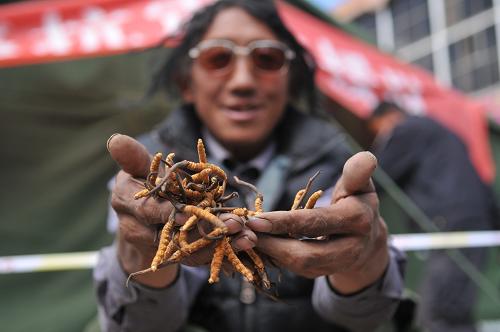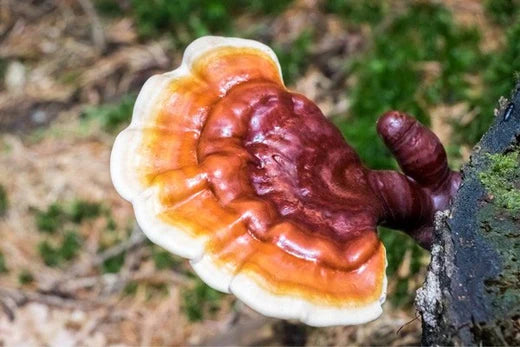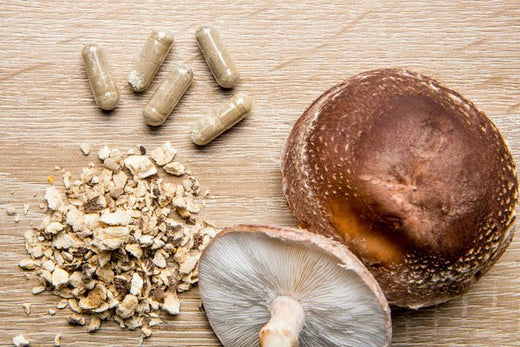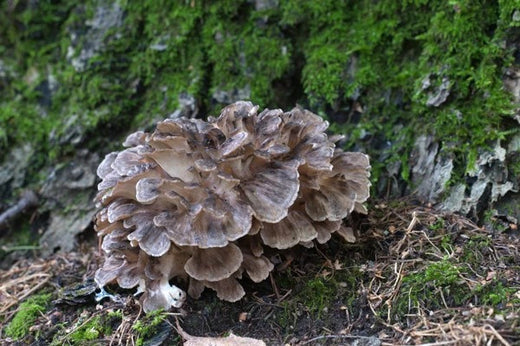The Finest Tonic Herbs - Organic or Wildcrafted, The Quest Begins!

Exciting News: Teelixir Embraces Certified Organic! Unveiling Our New Range of Herbal Delights.
After months of careful planning, we are thrilled to announce that Teelixir has officially become certified organic! This marks a significant milestone in our journey, as we introduce our brand new selection of Australian Certified Organic products, featuring our top-selling treasures such as Ashwagandha root powder, Reishi mushroom, Chaga mushroom, and Cordyceps mushroom.
Securing certified organic medicinal mushrooms has always been a key objective for us at Teelixir, and today, we proudly celebrate the fulfillment of this goal.
For years, it was widely believed that sourcing "certified organic" herbs from China was a challenging task, as the extensive implementation of the certified organic system was not prevalent throughout the country. We often wondered if finding a certified organic source would ever be possible.
China has long been renowned for producing the highest quality tonic herbs globally, a tradition that has stood the test of time. Hence, the quest for equivalent quality elsewhere seemed futile.
Obtaining medicinal mushrooms, in particular, proved to be a demanding endeavor, especially in their certified organic form.
We could have easily opted for certified organic lab-grown mushroom extracts, commonly derived from mycelium grown on grain products made in the USA.
However, if you're familiar with mushrooms, you'll know that this mycelium-on-grain (MOG) products are not only inexpensive but also inferior in quality, lacking the efficacy and medicinal potency we all seek.
For the finest quality, one must seek mushroom fruiting body extracts, cultivated exclusively on logs at high altitudes, with zero residual grain in the final product.
Identifying different parts of a mushroom may not always be straightforward, but it's crucial to note that the most significant health benefits reside in the fruiting body.
China's reputation as the leading producer of over 80% of the world's mushroom supply is well-deserved—they have consistently delivered the best quality.
Throughout the years, we clung to hope while tirelessly searching for certified organic mushrooms. We firmly believed in the impossible, and at last, we have struck gold.
Teelixir proudly stands as Australia's inaugural retail supplier of Australian-certified organic medicinal mushroom extracts.
Table of Contents
- 1. Unveiling the Certified Organic Distinction:
- 2. The Wildcrafted: Are They Truly Superior?
- 3. Introducing the Certified Organic Wild Chaga Mushroom:
- 4. The Challenges of Wildcrafting:
- 5. Introducing Cordyceps CS-4 as a Solution:
- 6. Embracing Wild Cultivation for Reishi Mushroom:
- 7. Distinguishing "True Wild" from "Wild Cultivated" Herbs:
- 8. Pros and Cons of Wildcrafting:
- 9. It's crucial to be conscious and aware.
- 10. Embracing an Organic Future:
- 11. References

Unveiling the Certified Organic Distinction:
When it comes to organic production, the Australian Certified Organic (ACO) standard reigns as one of the most esteemed and rigorous benchmarks worldwide. This exceptional standard sets forth various criteria that enable us to grasp the vital disparities and genuine essence behind the certified organic label. Here's an excerpt from ACO.com that sheds light on this:
Whole systems approach. Organics is not just “chemical free”. It is a whole systems or holistic means of growing and handling food. The whole system is linked – Soil. Plants. Animals. Food. People. Environment.
Friendlier. Certified Organic products are grown and processed without the use of synthetic chemicals, fertilisers, or GMO’s.
Innovative. Organic is an innovative method of farming and production – and is increasingly being recognised as being on the leading edge of food and fibre technology.
Market advantage. Educated consumers are happy to pay a fair price for the guarantee that the organic produce they purchase is supporting farmers who aim towards ecologically sustainable practices – looking after the environment we all share. The only way you can be assured you are buying genuine, organic products are to purchase those certified by Australian Certified Organic.
Scientific research consistently affirms that organic foods offer superior health advantages. Compared to conventionally grown and genetically modified foods, organic options are cleaner and boast a higher nutrient density. This can be attributed to the absence of fertilizers, pesticides, herbicides, and other harmful chemical additives throughout the entire farm-to-table journey. Additionally, organic soil composition is naturally richer in essential vitamins and minerals that promote the thriving of a healthy human body.
The Wildcrafted: Are They Truly Superior?
The topic of wildcrafted foods sparks intense debate, with claims that they may be "better" than organically cultivated foods for various reasons.
When we say "wildcrafted," we refer to foods that are harvested directly from nature, untouched by human intervention or cultivation. These are what we call "true wild" foods.
Have you ever stumbled upon stinging nettle growing in your backyard? Unless you intentionally planted it, that nettle is likely wild. Or perhaps while walking through a forest, you encountered a large blackberry bush and couldn't resist picking some luscious blackberries. Congratulations, you've just treated yourself to wild blackberries, directly sourced from Mother Nature. It's a pretty neat concept, isn't it?
Many herbalists concur that wildcrafted foods tend to be richer in nutrients and possess a heightened life force energy when compared to their organically cultivated counterparts.
"Generations of herbalists have emphasized the quality of wild versus cultivated plants. This bias was not based on plant constituency, which is often higher in cultivated species, but rather on the energetics of wild plants. There is a spirit, and energy inherent in wild things, both fauna and flora, that is apparent to anybody who has visited the last remaining wilderness areas of this country. That essence is hard, if not impossible to capture."
~ Planting the Future: Saving our Medicinal Herbs by Rosemary Gladstar
Wildcrafted foods are often considered to have more pronounced adaptogenic effects. These resilient foods must withstand constant and unpredictable environmental changes, including harsh weather conditions, competition from other plants, insects, and predators. It is believed that their ability to thrive under such stressful conditions infuses them with greater strength and adaptability, resulting in a herb with enhanced vital energy.
Unfortunately, unlike the Australian Certified Organic (ACO) standard, there isn't a solid regulatory body to determine what qualifies as true wildcrafted. Most wildcrafted foods fall into a growing category which makes it challenging to classify them as "organic." However, exceptions do exist.

Introducing the Certified Organic Wild Chaga Mushroom:
Consider the new certified organic wild Chaga mushroom—an extraordinary find. Some tonic herbs and mushrooms can only be sourced directly from the wild, and the Chaga mushroom (Inonotus obliquus) is one such species. The highest quality and most extensively studied Chaga mushrooms are found growing on birch trees.
Although Chaga mushrooms can be cultivated in a laboratory, there are compelling reasons to avoid that approach. Many functional mushroom products available today utilize inexpensive and ineffective mycelium grown on grain.
Scientific tests have shown that mycelium on grain (MOG) products contain significantly fewer valuable compounds like beta-glucans (polysaccharides), triterpenes, and ergosterols compared to wild or log-grown mushroom fruiting body extracts. Moreover, lab-grown mushrooms cannot replicate the same compounds as they do in their natural environment.
Chaga mushroom thrives almost exclusively on birch trees, drawing important precursor compounds such as the triterpenoid betulin from them. This betulin is then converted by Chaga into betulinic acid, inotodiol, and trametenolic acid. In contrast, lab-grown Chaga mushrooms are typically cultivated on grain substrates (MOG), which prevents them from producing the same triterpenoid compounds found in wild-harvested Chaga. As a result, lab-grown Chaga products are inferior, lacking a wide range of constituents that can only be found in wild-harvested Chaga.
The triterpenoids present in Chaga mushrooms offer remarkable health-promoting potential and contribute to its reputation as an ancient health tonic and anti-aging superfood. Hence, the best Chaga mushrooms are wildcrafted from birch trees.
Teelixir also offers other authentic wildcrafted tonic herbs, including Schizandra berry and Pine Pollen. These herbs, like Chaga mushroom, have been scientifically proven to be the most effective, sustainable, and cost-efficient when gathered in their wild form.
The Challenges of Wildcrafting:
While wildcrafting may be a preferable option for certain tonic herbs, there are significant economic and environmental challenges associated with improper practices, particularly regarding other wildcrafted superfood mushrooms like Reishi and Cordyceps.
Exploring the Economic Aspects of Wildcrafted Herbs:
Wildcrafted herbs are often priced higher due to their limited availability in the wild. The scarcity of wild materials, coupled with growing consumer demand, presents challenges for manufacturers to consistently supply these herbs on a large scale.

Consider genuine wild Reishi mushroom (Ganoderma lucidum), which can command prices ranging from hundreds to thousands of dollars per kilogram, depending on the age of the fruiting body (older specimens being more expensive). Why is it so costly?
Simply put, genuine wild Reishi is incredibly rare.
To give you an idea of its scarcity, for every 10,000 trees (dead or alive), you might stumble upon a single tree hosting wild Reishi mushrooms. Even then, the timing of your discovery must align with the fruiting body's optimal health and readiness for collection—not too early, not too late.

Now, let's turn our attention to Cordyceps mushroom, which holds the title of the world's most expensive herb.
Wild Cordyceps (Ophiocordyceps sinensis) from Asia is held in extremely high regard, often surpassing the value of gold. Its price can exceed $20,000 per kilogram.
However, the wild Cordyceps industry faces challenges of inauthentic materials and corruption. The exorbitant value associated with it attracts fraudulent products to the market, making it even more difficult to source genuine wild Cordyceps. Differentiating between wild and fake Cordyceps is a formidable task.
Moreover, there is a global shortage of Cordyceps Sinensis due to unsustainable collection practices, over-harvesting, and escalating environmental damage. The finest and most sought-after Cordyceps Sinensis grow in the Tibetan Himalayas. With the increasing popularity of these medicinal herbs, all wild resources in these regions face serious threats from excessive harvesting. The Chinese government, which oversees the Cordyceps industry, may need to implement harvesting bans for extended periods to ensure the survival of future crops. Specialists predict that, in the years to come, these valuable herbs could simply vanish.
The combination of the exorbitant price and the prevalence of inauthentic wild Cordyceps makes it incredibly challenging to source and sell genuine wild Cordyceps on a large scale. From an economic perspective, it is nearly impractical to offer them to consumers.
Considering the substantial price tag and the uncertainty surrounding authenticity, would you be willing to pay $1000 for 50 grams of Cordyceps with a 50/50 chance of it being genuine?
Introducing Cordyceps CS-4 as a Solution:
While scientists have not yet succeeded in growing Cordyceps sinensis fruiting bodies, they have discovered an alternative cultivation method that is more cost-effective and environmentally friendly.
Through modern fermentation technology, Cordyceps mycelium can be grown in large liquid tanks, allowing for the production of significant quantities of cultivated Cordyceps sinensis at a faster pace and lower expense. This cultivated variety is known as CS-4.
Numerous studies have indicated that CS-4 offers similar nutritional benefits and a chemical profile closely resembling that of wild Cordyceps sinensis. CS-4 is considered equally potent and effective. Additionally, as it can be cultivated in a lab, CS-4 is clean and does not have any negative environmental impact.
It is important to note that Cordyceps CS-4 is also suitable for vegans.
Embracing Wild Cultivation for Reishi Mushroom:

What exactly is "wild" cultivation?
In China, many herbal farmers recognize the value and significance of the wild environment in producing high-quality tonic herbs and natural food medicines.
Over the years, they have developed innovative methods of wild cultivation (also known as semi-wild cultivation) that yield herbs of comparable quality and potency to true wild varieties. These wild cultivation practices also have a considerably lower environmental impact, are cost-effective, and can be scaled up for mass production.
Wild cultivated herbs are grown from seeds or spores that are placed in a natural environment, such as a mountain forest or a desert, and allowed to grow naturally without human intervention.
The process of wild cultivation simulates the growth conditions experienced by true wild Reishi mushrooms. It enables the herb to naturally accumulate essential nutrients and energy, while also subjecting it to the challenging environmental conditions that enhance its adaptability.
Excitingly, scientific research has demonstrated that wild cultivation methods yield herbs with chemical profiles closely resembling those of true wild varieties. The quality of these herbs is consistently excellent and often surpasses that of wildcrafted alternatives.
Distinguishing "True Wild" from "Wild Cultivated" Herbs:
To clarify, wild cultivated herbs may not be true wild herbs, but they come close enough. Wild cultivation is the next best option.
In ancient times, superfood mushrooms were highly coveted and limited to the emperor and ruling elite. They reserved the supply for themselves, recognizing the herbs' value in enhancing longevity, strength, and overall well-being, allowing them to govern effectively.
Thankfully, centuries later, with the advent of wild cultivation farming, we now have access to these sought-after tonic herbs at a level of quality that was once exclusive to royalty.
Wild cultivation enables the consistent production of tonic herbs at high quality, on par with or even surpassing the wild variants. Moreover, it makes large-scale production economically viable, ensuring that these potent superfoods are accessible at affordable prices.

Pros and Cons of Wildcrafting:
While it's essential to acknowledge the downsides and potential pitfalls of the wildcrafting industry, when practiced correctly, the benefits of wildcrafting far outweigh the negatives.
Wildcrafting is a truly wonderful art and skill that demands respect. When pursued intelligently and with a deep appreciation for nature and the environment, it should never exploit or harm wild food communities but instead support and enhance them.
We strongly advocate for incorporating wildcrafted foods into our diet, aiming to consume them daily. You can start by purchasing wild greens and berries available at your local health food store. Many farmers' markets also offer locally harvested wild fruits and vegetables.
It's crucial to be conscious and aware.
Many herbal products on the market claim to be "wildcrafted," but not all use genuine true wild ingredients, yet they maintain elevated prices. This misinformation can be misleading, frustrating, and confusing for consumers. Therefore, it's important to conduct due diligence, ask questions, and make informed purchasing decisions for the health of ourselves and our families.
Embracing an Organic Future:
Regrettably, our world is becoming increasingly toxic with each passing day. Recognizing this reality and the dire situation we have created is the first step toward making positive changes for the future. The solutions are available, and technologies exist to help us undo the damage we have caused. Action is needed.
Adopting organic practices is the way forward for every industry in our society. It is crucial to set fresh benchmarks.
As Teelixir continues to grow, we are committed to finding better solutions and becoming a more ethical and environmentally responsible brand for the well-being of our planet and all its inhabitants. We value your input and invite you to join us on this mission.
Introducing Certified Organic Mushrooms at Teelixir
Our mission is to supply mushroom extracts of the best quality, made in an ethical and environmentally responsible manner. Our mushrooms are certified organic, low in heavy metals, free from toxins, and promote both your health and the well-being of the planet.
We count ourselves extremely fortunate to have easy access to both authentic wild and wild-cultivated organic mushrooms. Discover our new organic Chaga mushroom, Reishi mushroom, and Cordyceps mushroom online or at a store near you.
Stay tuned for more exciting announcements in the future!






